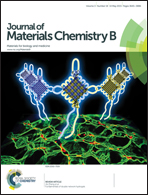Development of phenylboronic acid-functionalized nanoparticles for emodin delivery†
Abstract
Stable and monodisperse phenylboronic acid-functionalized nanoparticles (PBA-NPs) were fabricated using the 3-((acrylamido)methyl)phenylboronic acid homopolymer (PBAH) via the solvent displacement technique. The effect of operating parameters, including stirring time, initial polymer concentration and the proportion of methanol, on the self-assembly process was systematically investigated. The diameters of PBA-NPs were increased by increasing the initial PBAH concentration and the proportion of methanol. Likewise, there was a linear dependence between the size of self-assembled nanoparticles and the polymer concentration. Moreover, the dissipative particle dynamics (DPD) simulation technique was used to investigate the mechanism of self-assembly behavior of the PBAH, which indicated that the interior of PBA-NPs was hydrophobic and compact, and boronic acid groups were displayed on both the exterior and interior of PBA-NPs. The resulting PBA-NPs could successfully encapsulate emodin through PBA–diol interaction and the encapsulation efficiency (EE%) and drug loading content (DLC%) of drug-loaded PBA-NPs were 78% and 2.1%, respectively. Owing to the acid-labile feature of the boronate linkage, a reduction in environmental pH from 7.4 to 5.0 could trigger the disassociation of the boronate ester bonds, which could accelerate the drug release from PBA–emodin-NPs. Besides, PBA–emodin-NPs showed a much higher cytotoxicity to HepG2 cells (cancer cells) than MC-3T3-E1 cells (normal cells). These results imply that PBA-NPs would be a promising scaffold for the delivery of polyphenolic drugs.


 Please wait while we load your content...
Please wait while we load your content...